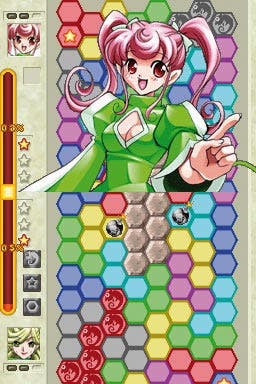DS Game Roundup
Monsters, mazes and more that you've never heard about.
Kameleon
I'm not clever enough (and don't have enough softmints) to play legendary Japanese strategy game Go, but I am clever enough to use that as the basis for Kameleon comparisons, since Star-Fish's puzzle strategy game sits firmly in that camp. Or at least sits close by and paints itself green while singing dementedly.
Known as Kuru Kuru Chameleon in its homeland (and also out on PSP for fans of the Sonyslab), Kameleon's a competitive puzzle game where you face off against another player or the AI in a battle to take over more than 50% of the hexagons on-screen. Starting off with one hexagon in the bottom-left corner, you look at the blocks adjacent to it and pick the colour you'd like to take over. Then your opponent, starting in the top-right of the top-screen, does the same.
If you form a solid line from side to side, you annex all the territory on your side, and as you both collect more and more of the available territory, you need to choose your moves carefully. You can't pick the colour that your opponent is using or the one that you chose last time, so thinking a few moves ahead is vital if you're to avoid being pushed in a direction you don't want to go. There are also obstacles to avoid - dead brown blocks that you can't use, and bombs that sit on certain colours that, if annexed, explode and randomise the colours of their surrounding hexagons, which completely changes the dynamic of that area of the board. Adding to the tension is a time limit on each of your turns, although fortunately this can be turned off.

Both players also have some special abilities to take advantage of, depending on the character chosen before the game started (not just a pretty face, see). These abilities become available once you've taken over hexagons with special stars in them, and have two levels of effectiveness. "Delphi", for example, can turn obstacle blocks into neutral ones, but if she waits until she has three stars of special power, she can neutralise bombs, which is potentially more useful.
It's not just about taking over most of the space, either - some levels require you to reach a hexagon with a flag on it instead, or to take over the majority of the special "King" zones, which need to be surrounded on more than half their exterior to fall under your control. As well as multiple gameplay types, there are other modes, too - the single-player Normal mode is round-limited, but there's also Endless mode (mistakenly referred to as "Continuous" by the instruction booklet), and a single-card wireless game for two players.
Weirdly though, despite an explanation in the manual, Story mode is completely absent. If you play the Japanese version, it's second-from-top on the main menu, with wacky cut-scenes and everything, but there's no sign of it in our PAL DS copy. 505 Games tells us it was cut and that the entry in the manual is a production error. Presumably it was simply cheaper not to translate it. Still, Story mode's absence isn't sorely felt (unless you really were interested in what Elliot, Crest, Eboshi and Delphi get up to outside work - thought not), as there's plenty of gameplay in the other two.
All of which has its moments (particularly when you turn off time-limits, which needlessly enforce tension that otherwise builds up naturally), but still feels a bit flat, and the power-ups and explosive blocks feel like knowingly disruptive elements designed to make up for the inevitability of the outcome. Look far enough ahead in a game with no power-ups and it would be like playing noughts and crosses.
Then again, noughts and crosses can be fun, there is a certain charm to plotting your approach, and the only other criticism is that you can't browse around the larger boards during your opponent's turn. Besides that, it's agreeable - if a little reliant on your not asking too many questions - although fans of actual puzzles have plenty of other options.
